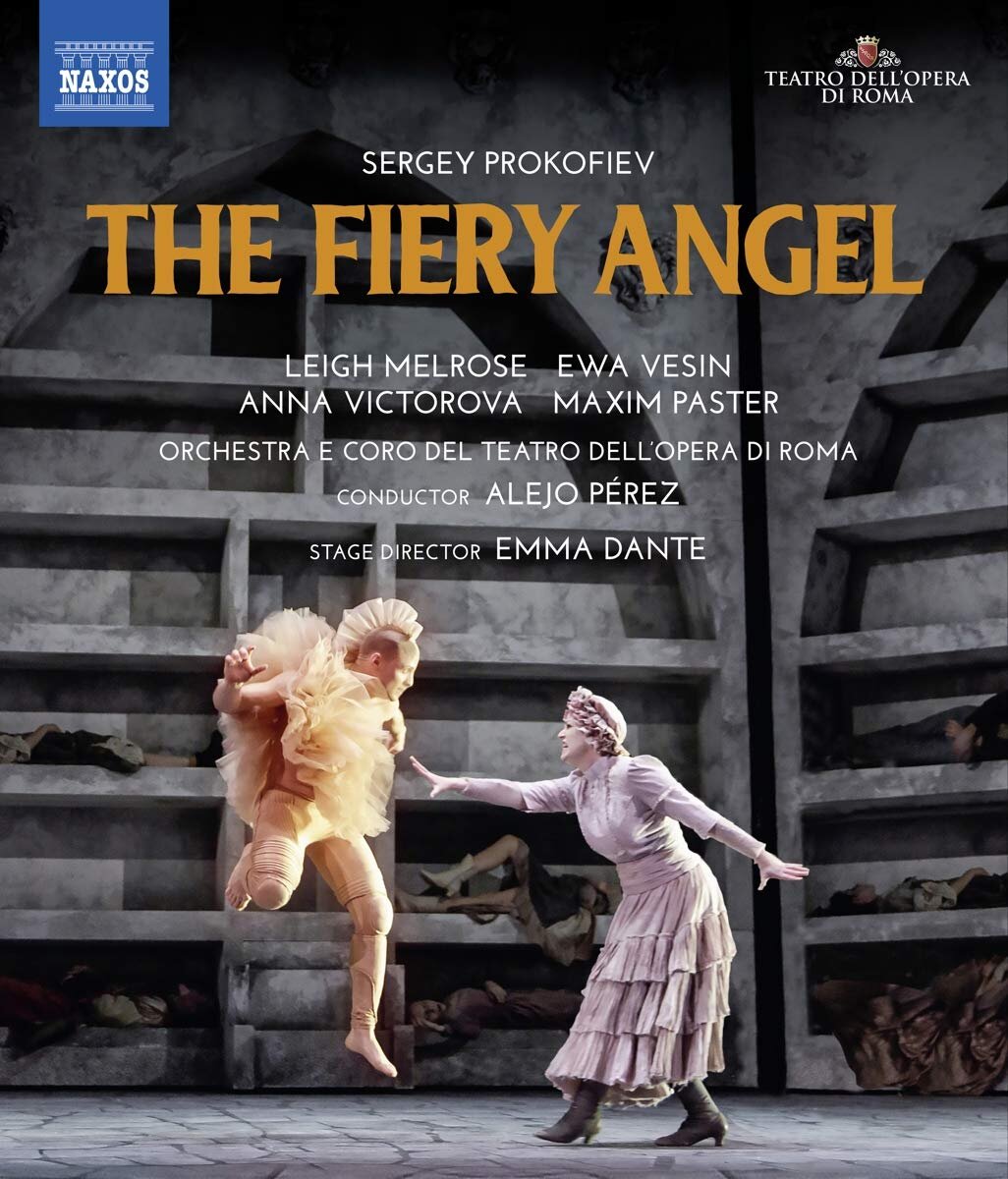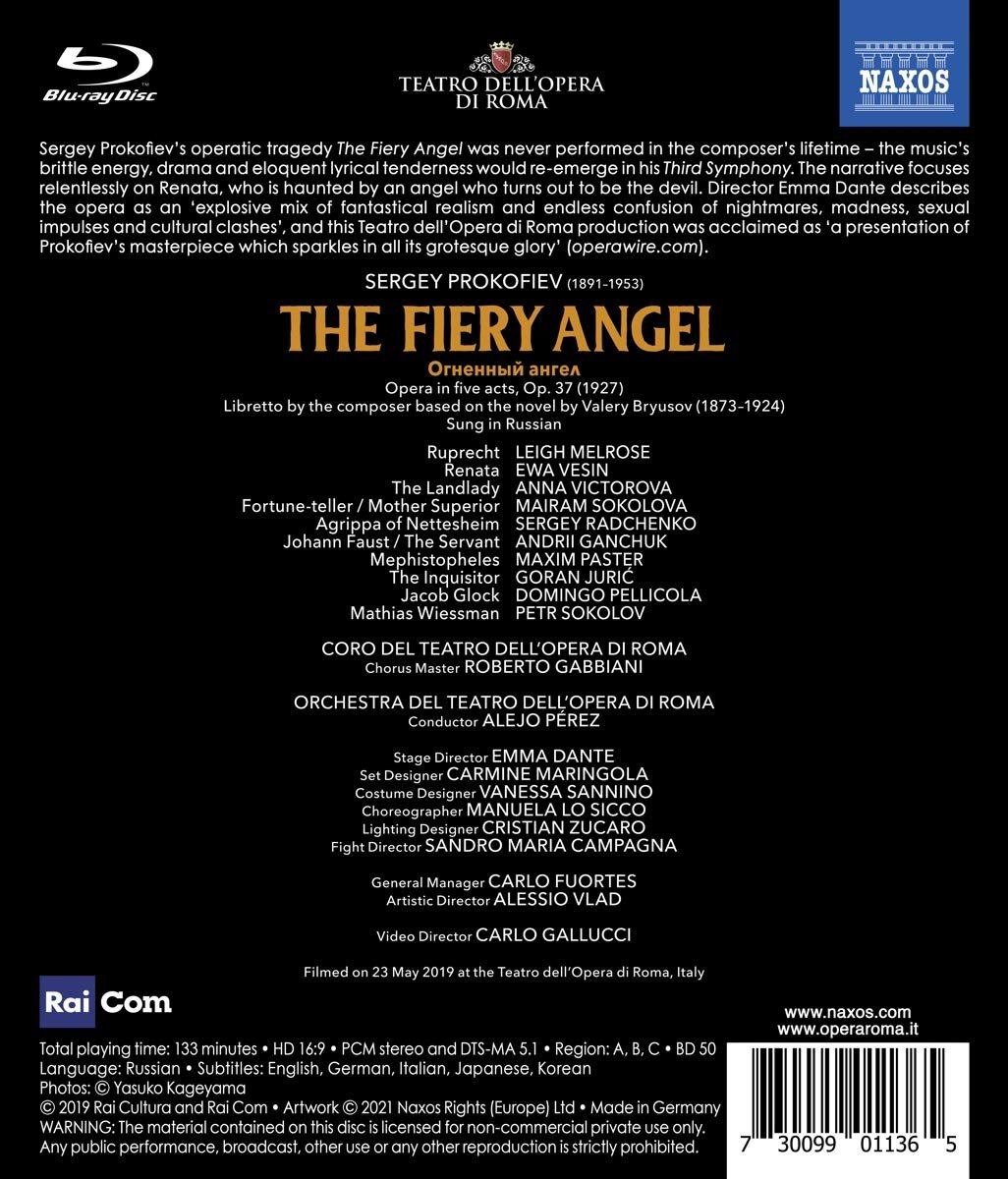

Prokofiev The Fiery Angel opera to libretto by the composer. Directed 2019 by Emma Dante at the Teatro dell’Opera di Roma. Stars Leigh Melrose (Ruprecht), Ewa Vesin (Renata), Anna Victorova (The Landlady), Mairam Sokolova (Fortune-teller/Mother Superior), Sergey Radchenko (Agrippa of Nettesheim), Andrii Ganchuk (Johann Faust/The Servant), Maxim Paster (Mephistopheles), Goran Jurić (The Inquisitor), Domingo Pellicola (Jacob Glock), Petr Sokolov (Mathias Wiessman), Murat Can Güvem (The Doctor), Timofei Baranov (The Innkeeper), Arianna Morelli (First Nun), and Emanuela Luchetti (Second Nun). Alejo Pérez conducts the Orchestra del Teatro dell’Opera di Roma and the Coro del Teatro dell’Opera di Roma (Chorus Master Roberto Gabbiani). Set design by Carmine Maringola; costume design by Vanessa Sannino; choreography by Manuela lo Sicco; lighting design by Cristian Zucaro; fight direction by Sandro Maria Campagna. Directed for TV by Carlo Gallucci. Sung in Russian. Released 2021, disc has 5.1 dts-HD Master Audio sound. Grade: A
The libretto of The Fiery Angel opera is based on the eponymous novel by Valery Bryusov (1873-1924), whose portrait is seen below left. Valery was in love with Nina Petrovskaya (1879-1928), also a writer, seen on the right. Nina was in love with Andrei Bely (1880-1934), yet another writer, seen below in the chair. Eventually Nina took up with Valery, but she remained in love with Andrei. Valery poured out his frustration about this in The Fiery Angel novel, in which Valery became the character Ruprecht, Nina became Renata, and Andrei became the Fiery Angel. All of these Russian intellectuals were members of the symbolist school which was mainly inspired, according to the New World Encyclopedia, by the works of Wagner, Schopenhauer, Nietzsche, Mallarmé, Baudelaire, and Ibsen. They also believed in the occult—Valery even tried to get rid of Andrei with a private exorcism!
The novel The Fiery Angel is considered to be one of the great works of decadent occultism. But today it is hard to find a copy of the English translation for sale except through specialists. And only a most fanatical opera fan would have the energy to read 400+ pages about occult practices in medieval Germany just to prep for watching Prokofiev’s opera. I’ll save you the trouble: the opera can be summed up by a line from Mephistopheles in the opera saying in effect, “Mortals are so complicated and creative: neither angels nor demons are clever enough to predict what they will do next.”
Our story opens in a cheap inn in Germany. This dump just happens to look like the Catacombs of the Capuchins in Palermo, Italy, where thousands of corpses, many elaborately dressed and preserved, today amuse tourists. Most of the Palermo corpses rest lying down. Images like the next below obviously inspired Carmine Maringola’s opening and closing sets in Dante’s production:
In Act 1, Renata (Ewa Vesin) is first seen trying to sleep standing up when she is threatened by a break-dancing demon:
The image above of Dante’s Renata was possibly inspired by a combination the next two images below: on the left is a standing female corpse and on the right is Rosalia Lombardo preserved in pink. True facts are more macabre than anything an artist could dream up:
Below more Capuchin truth more grotesque than fiction:
Now back to our opera. Hearing Retana in distress, a Knight named Ruprecht (Leigh Melrose) jumps up from his grimy bed to offer aid—he can’t see the demon:
This opera is sung in Russian. I understood the word “Da” (“Yes”) once. I also understood Ruprecht singing “Libera me” in Latin. I was able to hear the Russian clearly—but the language is an dense thicket of thorns for anyone used to operas in Germanic or Romance tongues. But as you can see in our screenshots, the subtitles in English are pretty good.
Ruprecht is totally baffled by the commotion, but he senses that evil is afoot:
Ruprecht tries to reason with Renata while the corpses come to life as if in an insane asylum:
Renata launches into an elaborate story of a romance she had as a girl with a Fiery Angel:
The romance began in purity:
Renata believed she was on her way to beatification and sainthood. Director Dante is primarily a theater person. She adds to the chorus 15 moot actors from her regular theater troop (as well as the breakdancing demons). Dante worked closely with TV director Garlo Gallucci to add to the video many beautiful images of her actors. As soon as Renata starts to tell her story of the romance with the Angel, the corpses suddenly gather around in rapt attention: this is a quote, I think, of Tamino charming the wild beasts in Mozart’s Zauberflöte:
Renata also believed the Angel when he said that love was the highest of all things; at this point, the corpses are totally absorbed with Renata’s tale:
Renata turned 16. She asked her Angel for sex, and the Angel abandoned her in fiery fury. Renata believes the Angel has returned in human form as a nobleman named Heinrich, who lives in Cologne. She asks Ruprecht to help her find Heinrich. Ruprecht has fallen in love with Renata and agrees to take her to Cologne. But before they can depart, a fortune teller conducts a gory ceremony (with actors tossing skulls and bones around like circus jugglers) predicting a bloody end for Renata:
So already we see that this will not be a typical opera with a dilemma, growing tension, a climax, and a denouement. This is an opera of conflicting ideas that will be presented in various guises in a series of episodes. And what are these conflicting ideas? I’ll cheat at his point by listing the ideas mentioned by theater expert Rodolfo di Giammarco and Emma Dante herself discussing this in the keepcase booklet: good vs. evil, reason vs. madness, natural vs. supernatural, realism vs. nightmares, cultural clashes, and the heavenly-hellish nature of the sex drive. There will be no edification or resolution of anything: this will be an intellectual roller-coaster trip ending poorly for Renata as predicted by the fortune-teller. Before the thrill ride is over, Dante will miss no opportunity to inject creepiness into the show. But the general mood is not that of horror—it’s more black humor. Dante states in the keepcase booklet that, in her view, Prokofiev was more more interested here in passion than ethics.
In the next screenshot below, we see an interlude between Act 1 and Act 2 with actors reading occult books that might help Renata find Heinrich:
Frustrated by the fruitless search for Heinrich, Renata is ready to seek aid from the Devil:
Bookseller Jacob Glock helps out with forbidden texts:
Mysterious ghosts abound:
Ruprecht seeks guidance from Agrippa of Nettesheim (Sergey Radchenko), an early-modern-era physician, philosopher, and proponent of magic, which he defined not as the exercise of supernatural powers or tricks of illusion, but as the possession of comprehensive knowledge:
Finally, Renata finds Heinrich (silent role played by an unaccredited actor), who spurns her again:
Renata decides she should accept Reprect’s love, but only if he will kill Heinrich in a duel:
Heinrich has the upper hand as demi-god and Ruprecht is defeated:
Which leads Renata to reciprocate Ruprecht’s love:
Next below another interlude with a moot, comic, sarcastic reenactment of the duel between the Ruprecht and Heinrich. This clever scene got enthusiastic support from the audience:
Renata agrees to marry Ruprecht. But soon she relents and decides to enter a convent for protection from the stresses of the world:
Even Mephistopheles and Dr. Faustus are baffled by Renate’s fickleness:
When Renata arrives at the convent, trouble breaks out among the sisters.The Inquisitor comes to exorcise the demons that have followed Renata into the convent: :
The exorcism fails as the nuns fall victim to mass hysteria:
Renata is stripped of her habit and is now seen in black. The inquisitor calls Renata a demon:
Renata is condemned to torture and execution. But Renate will prove to be a slippery victim—watch the disc for Dante’s conclusion:
Prokofiev worked on this for many years, but he never saw it produced. The Fiery Angel was produced 15 times somewhere in the world during the last 5 years (Opera Base), so it’s not totally forgotten. Still, it appears there was, prior to this show, no recording of the opera in any format in print and available as new merchandise in the West. Experts may know how to locate recordings made in Russia for that market. So we are lucky now to have this new HDVD recording. It would seem that Prokofiev’s dark and sarcastic writing style was perfect for The Fiery Angel. And Dante knew how to use black humor as yeast for her gruel.
Dante’s production was a huge success live in Rome. The star singers, chorus, and orchestra under Alejo Pérez have been applauded by most of the critics. On June 3, 2019, Alan Neilson wrote a glowing review of this live production for operawire.com. And Renato Verga, writing for bachtrack.com on May 25, 2019, says this is “classified as the weirdest and creepiest opera ever written.” A minority report comes from David Shengold, writing in the May 2021 Opera News (pages 48-49), who concludes this is a “flawed but powerful take on a flawed but powerful opera.”
As can be seen in the screenshots and the trailer below, Carlo Gallucci managed to make an excellent video file with a deliberately grayed-out pink patina suggesting the gloom of catacombs. SQ is also good. This unique video gets an A as an elaborate and skillful presentation of this major opera from Prokofiev.
Here’s a trailer from Naxos:
OR


































